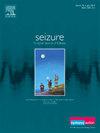Efficacy of repetitive transcranial magnetic stimulation (rTMS) therapy in children with drug refractory focal epilepsy – A randomized trial
IF 2.8
3区 医学
Q2 CLINICAL NEUROLOGY
引用次数: 0
Abstract
Background
Low frequency repetitive transcranial magnetic stimulation (rTMS) can suppress local neural circuits beyond the stimulation period and can be a potential treatment option for focal epilepsy. This study analysed the short-term effect of rTMS on seizure frequency, EEG, behavior, and cognition in children with drug refractory focal epilepsy (DRFE).
Methods
This is a single center, randomized double-blind sham controlled clinical trial (CTRI/2019/02/017,440). Children aged 5 to 18 years with DRFE with ≥ four focal seizures per month despite on ≥ two appropriately chosen antiseizure medications (ASMs) randomly received active or sham rTMS treatment along with the ongoing ASMs. Intervention comprised of 45 min rTMS sessions of 0.5 Hz (1200 pulses at 110 % of resting motor threshold (RMT) targeted over seizure focus using figure-of-8 coil for 10 consecutive days. The primary outcome was to compare the proportion of children who achieved >50 % seizure reduction in active and sham arm at 8-week post-therapy.
Results
Forty-nine children were enrolled in the trial (25 active and 24 sham). All randomized participants received the allocated treatment. No attrition occurred. Active rTMS therapy led to >50 % seizure reduction in 76 % (19/25) children versus 12.5 % (03/24) in sham arm (p < 0.0001) with absolute risk difference (95 % CI) between the groups was 0.68 (0.52, 0.84). Mean (SD) reduction in spike wave index (SWI) in sleep EEG was 34.4(29.9) with rTMS vs -1.89(22.5) in sham arm with absolute risk difference (95 % CI) -36.4(-51.7, -21.1). Between active and sham group mean (SD) change in Intelligence quotient (IQ) was 3.7(2.8) vs -0.91(3.1), p value 0.001; Child Behavior Checklist (CBCL) scores improved in behavioral domains of inattention (-5.5(3.8) vs 0.41(2.7), p < 0.001; hyperactivity -3.8(4.1) vs -0.5(2.8), p < 0.006 and aggression -4.1(2.4) vs 0.40(2.8), p < 0.001. Adverse effects were primarily limited to headache and scalp discomfort.
Conclusion
Adjunctive low frequency rTMS may induce better short-term seizure control and electrographic improvement compared to sham stimulation in children with DRFE. These results will serve as a basis for a larger multicentric clinical trial.
反复经颅磁刺激(rTMS)治疗儿童药物难治性局灶性癫痫的疗效-一项随机试验
背景低频重复经颅磁刺激(rTMS)可以在刺激期后抑制局部神经回路,可能是局灶性癫痫的潜在治疗选择。本研究分析了rTMS对药物难治性局灶性癫痫(DRFE)患儿发作频率、脑电图、行为和认知的短期影响。方法采用单中心随机双盲假对照临床试验(CTRI/2019/ 02/017440)。年龄在5 - 18岁的DRFE患儿,尽管服用了≥2种适当选择的抗癫痫药物(asm),但每月有≥4次局灶性癫痫发作,随机接受主动或假rTMS治疗,同时接受持续的asm治疗。干预包括45分钟的0.5 Hz rTMS会话(1200次脉冲,静息运动阈值(RMT)的110%),连续10天使用8字线圈瞄准癫痫发作焦点。主要结果是比较治疗后8周活动臂和假臂癫痫发作减少50%的儿童比例。结果49例儿童入组,其中25例为活动儿童,24例为假儿童。所有随机的参与者都接受了分配的治疗。没有发生磨损。积极的rTMS治疗使76%(19/25)儿童癫痫发作减少50%,而假组为12.5% (03/24)(p <;0.0001),组间绝对风险差(95% CI)为0.68(0.52,0.84)。rTMS组睡眠脑电图的峰值波指数(SWI)平均(SD)降低为34.4(29.9),而假手术组为-1.89(22.5),绝对风险差异(95% CI)为-36.4(-51.7,-21.1)。活动组和假手术组智商(IQ)的平均(SD)变化分别为3.7(2.8)和-0.91(3.1),p值0.001;儿童行为检查表(CBCL)得分在注意力不集中的行为领域有所改善(-5.5(3.8)vs 0.41(2.7), p <;0.001;多动症-3.8(4.1)vs -0.5(2.8), p <;0.006和攻击性-4.1(2.4)vs 0.40(2.8), p <;0.001. 不良反应主要限于头痛和头皮不适。结论与假刺激相比,辅助低频rTMS对DRFE患儿的短期癫痫发作控制和电图改善效果更好。这些结果将作为更大规模的多中心临床试验的基础。
本文章由计算机程序翻译,如有差异,请以英文原文为准。
求助全文
约1分钟内获得全文
求助全文
来源期刊

Seizure-European Journal of Epilepsy
医学-临床神经学
CiteScore
5.60
自引率
6.70%
发文量
231
审稿时长
34 days
期刊介绍:
Seizure - European Journal of Epilepsy is an international journal owned by Epilepsy Action (the largest member led epilepsy organisation in the UK). It provides a forum for papers on all topics related to epilepsy and seizure disorders.
 求助内容:
求助内容: 应助结果提醒方式:
应助结果提醒方式:


